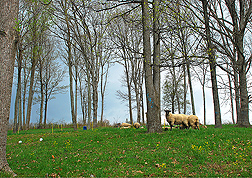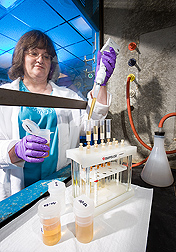Taking a Closer Look at Tannins
The tannins that bring us good red wine and fall colors may also be those that make soil good and livestock healthy. Phenolic compounds, including tannins, are common in many plants. These compounds are believed to enter soil from plant roots, from decaying leaves, and possibly from “teas” formed as rain and snowmelt run down tree bark and drip off the leaves.
Javier Gonzalez, a chemist, and Jonathan Halvorson, a soil scientist, at the Agricultural Research Service’s Appalachian Farming Systems Research Center (AFSRC) in Beaver, West Virginia, head a tannin project, now in its third year. Together with studies by other AFSRC scientists, their work indicates that tannins are important components of agroecosystems that can affect production and environmental quality.
Tannins and Silvopastures
The researchers became interested in tannins through their work with silvopastures, intentionally thinned wooded areas used to graze livestock. Soil processes and water quality in silvopastures may be influenced by the mix of trees or the type of compounds they release into soil.
Halvorson and Gonzalez wondered whether some species would add different chemical compounds, including tannins, to soil than others. They also wanted to know how the thinning would affect the types and amounts of tannins in soil and, in turn, the effects on soil organic matter and the entire ecosystem.
It all came down to one main question for Gonzalez: “Which trees should I cut down to make room for grazing livestock and not adversely affect soils in the long term?”
|
|
She Wrote the Book on Tannins
A call from Halvorson with a question about tannins early in the project brought in the expert who literally wrote the book on tannins, Ann Hagerman.
Hagerman, of Miami University in Oxford, Ohio, is an expert on tannin chemistry. She wrote the Tannin Handbook, a compilation of methods developed in her laboratory for analyzing tannins.
Hagerman says, “Tannins in the environment are not a new topic. They’ve been targeted as being important players in soil formation and water chemistry for many years. But our understanding of the processes has been hampered for a long time by the very use of the term ‘tannin.’
“The problem is that there are probably at least 1,000 very distinct compounds that all fall into the category ‘tannin.’ This is where my chemistry background comes into play. When my lab does an experiment, we don’t think ‘tannin’—we go for a specific compound with a specific, known chemical structure.”
Testing Tannins’ Many Roles
A cooperative agreement, combining the capabilities of Hagerman’s lab with those of AFSRC, was developed to identify important features of tannins that determine their interaction with soils. Results from joint studies by Miami University staff and students and ARS scientists will be used to develop recommendations for using tannins to manage soil.
Halvorson, Gonzalez, Hagerman, and colleagues added tannin solutions to forest and pasture soil samples and found that the rate and amount of binding to soil varied by the type of tannin present. With ARS scientists from Pendleton, Oregon, they also tested the influence of different soil amendments on tannin binding and compared soils from around the United States and Canada. Halvorson and Gonzalez also observed how some tannins interact with soil proteins, another indicator of the important role of tannins in soils.
ARS scientists are also learning more about how tannins interact with important metals in soil. Studies headed by Gonzalez and a postdoctoral scientist at Miami University are determining how metals are mobilized in the soil by phenolic compounds related to tannins. In other work with Hagerman, AFSRC plant physiologist Thomas Kinraide found that binding by tannins may alleviate the toxic effects of metals, such as aluminum, on root growth.
Hagerman and ARS colleagues are also beginning studies of how forest soil microbes metabolize tannins and related compounds. They are using a device that measures CO2 emitted from microorganisms in soil. “We found the technique allowed us to accurately compare soil microbial responses to various tannin compounds,” Hagerman says. “This should help us learn about the varied ecological functions performed by tannins.”
Tannins May Benefit Livestock, Too
Other AFSRC scientists, including chemist Joyce Foster and animal scientist Kenneth Turner, are evaluating the nutritional and deworming potential of tannin-containing forages, like birdsfoot trefoil for goats.
With the knowledge gained from this project, scientists expect to learn how to manage agricultural soils for the benefit of production and the environment by taking advantage of natural help from certain tannins.—By Don Comis, Agricultural Research Service Information Staff.
This research is part of Pasture, Forage, and Range Land Systems (#215), an ARS national program described at www.nps.ars.usda.gov.
To reach scientists mentioned in this story, contact Don Comis, USDA-ARS Information Staff, 5601 Sunnyside Ave., Beltsville, MD 20705-5129; (301) 504-1625.
"Taking a Closer Look at Tannins" was published in the November/December 2010 issue of Agricultural Research magazine.









